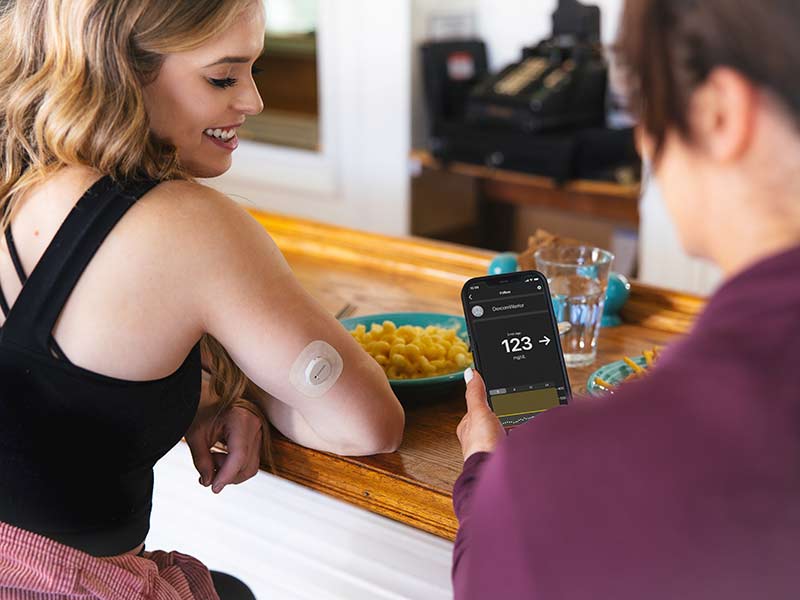Scheduled maintenance is planned for Dec. 13–14. You may experience brief interruptions during this time.
Making the Invisible Visible in Type 2 Diabetes Management

Continuous glucose monitoring (CGM) has long been thought of as a tool for people managing diabetes and treated with intensive insulin therapy. A growing body of evidence, however, suggests that benefits of CGM extend to those treated with non-intensive insulin therapy, as well as those treated with non-insulin therapies.1
While NHANES data indicate that only 50% of people with diabetes (PWD) are reaching A1C goals of <7%,2 those provided CGM demonstrate significant reductions in A1C within a matter of months, even reaching A1C values <7%.3 Notably, in a recent 6-month study performed in people with type 2 diabetes (T2D) treated with basal insulin or non-insulin therapies, participants initiated on real-time CGM experienced an average 3% reduction in A1C (P<0.001).3 Similar reductions were observed for participants whether they were treated with ≤1 or ≥2 diabetes medications.
Each year, 1.2 million adults are diagnosed with diabetes.4 Navigating a new T2D diagnosis can generate feelings of shock, denial, and helplessness,5 and without effective tools to know which behavior change(s) to make and if they are helping, crucial time may be lost in taking action for better health. The future risk of long-term complications related to diabetes and mortality is strongly associated with diabetes management soon after diagnosis.6 Individuals with A1C values ≥6.5% in the first year after T2D diagnosis show worse long-term microvascular and macrovascular outcomes compared to those with A1C ≤6.5%.7 The value of CGM in diabetes management exists regardless of insulin use,3 and it can be a critical tool in helping those newly diagnosed with diabetes learn quickly, stay engaged, and optimize their glycemic management to promote long-term health.
Watch this video presentation to learn about the use of real-time CGM as a motivational support tool in T2D from two experts in diabetes management, William Polonsky, PhD, CDCES, and Thomas Grace, MD, CDCES. Together, they discuss how CGM can promote behavior change, improve quality of life, and reduce A1C in all PWD.
MAT-1195v2.0
REFERENCES
- Aleppo G, Hirsch IB, Parkin CG, et al. Coverage for Continuous Glucose Monitoring for Individuals with Type 2 Diabetes Treated with Nonintensive Therapies: An Evidence-Based Approach to Policymaking. Diabetes Technol Ther. 2023;25(10):741-751. doi:10.1089/dia.2023.0268
- Fang M, Wang D, Coresh J, et al. Trends in diabetes treatment and control in U.S. adults, 1999–2018. N Engl J Med. 2021;384:2219–2228. doi: 10.1056/NEJMsa203227
- Grace T, Salyer J. Use of Real-Time Continuous Glucose Monitoring Improves Glycemic Control and Other Clinical Outcomes in Type 2 Diabetes Patients Treated with Less Intensive Therapy. Diabetes Technol Ther. 2022;24(1):26-31. doi:10.1089/dia.2021.0212
- Centers for Disease Control and Prevention. National Diabetes Statistics Report. Incidence of Newly Diagnosed Diabetes. September 2022. Accessed November 6, 2023. https://www.cdc.gov/diabetes/data/statistics-report/newly-diagnosed-diabetes.html
- Boakye MDS, Miyamoto S, Greenwood D, Kraschnewski J, Van Haitsma K, Boltz M. Pathway From Type 2 Diabetes Diagnosis to Action: How to Move People Forward. Diabetes Spectr. 2023;36(3):264-274. doi:10.2337/ds22-0058
- Holman RR, Paul SK, Bethel MA, Matthews DR, Neil HA. 10-year follow-up of intensive glucose control in type 2 diabetes. N Engl J Med. 2008;359(15):1577-1589. doi:10.1056/NEJMoa0806470
- Laiteerapong N, Ham SA, Gao Y, et al. The Legacy Effect in Type 2 Diabetes: Impact of Early Glycemic Control on Future Complications (The Diabetes & Aging Study). Diabetes Care. 2019;42(3):416-426. doi:10.2337/dc17-1144
Disclaimer:
The posting of information and content on this page should not be considered an AAFP endorsement or recommendation of the partner or sponsor organization’s products, services, policies or procedures. The information and opinions expressed are those of partners and paid sponsors and do not necessarily reflect the views of the AAFP. The AAFP is not responsible for the content of third-party websites linked from this page. Any links on this page to third-party websites where goods and services are advertised are not endorsements or recommendations by the AAFP of the third-party sites, goods or services.